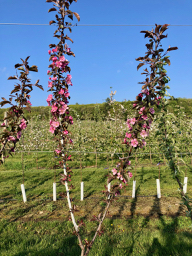
New England Cider Apple Project (NECAP) – Introduction
Terence Bradshaw (Project Director)
University of Vermont Tree Fruit & Viticulture Specialist
63 Carrigan Drive, Burlington, VT 05405
tbradsha@uvm.edu www.uvm.edu/~fruit
Jon Clements, Dan Cooley, Elizabeth Garofalo, Jaime Pinero
University of Massachusetts Amherst
Renae Moran
University of Maine
In a recent survey of apple growers, one prominent Vermont apple grower stated, “The cider apple market represents the first real increase in demand for New England Apples in a generation. While sales of our dessert fruit have been flat or declining, we see this market as essential to maintaining the competitiveness of our industry.”
Fermented cider production in New England experienced over 50% annual growth from 2009 to 2014 and sales of regional craft ciders made from specialty cider apples increased over 40% in 2017. That last figure is especially important, because cideries use two sources of apples for making their products: culled fruit of traditional dessert apple varieties (e.g. ‘McIntosh’, ‘Empire’, etc.); and specialty varieties grown specifically for their unique flavor and aroma contributions to the finished cider. The former of these apples make up the lion’s share of fruit used for making cider in the U.S., and their production requires a wholesale dessert variety market that provides sufficient revenue so that growers can afford to sell culls at substantially lower prices. At regional educational meetings in 2014-2017, and in national surveys since 2014, apple growers stated that biennial bearing, variety adaptability, appropriate orchard training systems, and increased susceptibility to specific diseases, particularly fire blight, present significant limitations to increased expansion of cider apple production.
Specialty cider apple varieties, however, present greater value as cider apples than dessert varieties that are downgraded for cider use. Thus, cider varieties do indeed present opportunity for diversification of New England orchards without substantially changing production systems. Currently, the demand for cider apples exceeds supply, and apple varieties specifically selected for cider (e.g. ‘Dabinett’, ‘Ashmead’s Kernel’, ‘Franklin Cider Apple’) offer high returns for growers. Cider apples also have lower infrastructure and management needs because lack of demand for blemish free fruit creates an opportunity to grow them with fewer chemical inputs. In addition, postharvest cold storage, sorting, and packing are greatly reduced compared to dessert apples. However, production of cider apples is limited by unknown performance metrics for specialty cider apple varieties when grown in New England, unique pest management considerations including greater susceptibility to fire blight, and alternate bearing cycles that reduce yield. There is a dearth of objective, research-based information on cider variety performance across New England orchards. However, there are many growers whose expertise growing these fruit can be collected through citizen science to develop regional recommendations for cider apple production. In addition, new methods for managing crop load through use of plant growth regulators and/or canopy hedging could address biennial bearing issues that reduce cider variety productivity.
New England Cider Apple Project
In fall 2019, specialists from the Universities of Maine, Massachusetts, and Vermont initiated the New England Cider Apple Project (NECAP) with funding from Northeast SARE Research and Education Program. This project will includes four research projects that will yield valuable information for New England fruit growers:
- Cider variety observations. In 2019, NECAP staff began collecting field observations of cider varieties in several orchard in Vermont and Massachusetts. Data is being collected on tree growth (vigor, habit); biennial bearing tendency, crop yield; juice quality; and incidence of disease and pest damage. Beginning in 2020, we will solicit growers for your observations and data, if available, to build out profiles of popularly-grown cider apple varieties in the region.
- Mechanical thinning research. Traditional European cider varieties do not respond as well to chemical thinners as most dessert varieties. In Maine, we will evaluate the effectiveness of a mechanical string thinner for effectiveness in early flower thinning, yield, and biennial bearing.
- Return bloom: Plant growth regulators and 4. canopy hedging. The success of the highly biennial dessert variety ‘Honeycrisp’ has led to research on and recommendation for treatments to improve annual bearing tendency. The use of post-thinning plant growth regulators and trimming vegetative shoots through hedging cam improve return bloom the following year independent of crop thinning. These treatments will be tested on commercially-important cider varieties to assess their effects on crop yield, return bloom, and fruit quality.
Work completed to-date is preliminary, and thus we are not ready to make recommendations based on it. The intent of this session is to introduce the project to cider apple growers from across the region to invite participation in project activities, including collection of observations from your orchards. As this project unfolds, we will publish results on the NECAP website at http://go.uvm.edu/necider.
Funding for this project is provided by NESARE Grant LNE19-373.
